Plasma is often described as the fourth state of matter. Since it makes up more than 99% of the Universe, it should be reckoned the first state. As has been proposed in previous articles, the Sun is an example of plasma and its normal behavior. Although the general premise is probably thousands of years old—that Earth is somehow an electrical entity—it has only been in the last 100 years that scientists have given serious credence to the possibility that we could be living in a dynamic Solar System where electricity plays an important role. The Sun's electric field extends for billions of kilometers, influencing the planets in their motions, as well as how they interact with each other. In September of 2002, a major premise of Electric Universe theory was confirmed: weather systems on Earth are electrically connected to the field of charged particles called the ionosphere. Dual bands of plasma shining in ultraviolet light were detected by the IMAGE satellite. The plasma streams are circling the Earth in opposite directions along the equator, carrying positive and negative electric charges. Another example of the Sun's intimate association with Earth are the polar aurorae. The curtains of blue, green, and red that hang down from the sky like wind-wavering veils of color have both puzzled and entranced observers for countless millennia. In 1621, Pierre Gassendi called the shimmering lights seen in the Arctic the Aurora Borealis after Aurora, the Roman goddess of dawn, and Boreas, the Greek name for the north wind. In the south polar region the same phenomenon appears and is known as Aurora Australis, literally "Southern Dawn" in Latin, or more conventionally, "Southern Lights". Solar ions follow Earth's magnetic field down into the poles, causing atmospheric molecules to emit light: red from oxygen at high altitudes, then green from oxygen lower down, along with blue from nitrogen. The electric charges travel down magnetic flux tubes that have recently been discovered. These "electromagnetic funnels" are several kilometers wide and allow electric currents to flow directly from the Sun into the polar regions, generating colorful visible light, radio waves, and X-rays. The power generated by electric currents in auroral storms is far greater than anything that human beings can create with every coal-burning, oil-fired, or water-driven means combined. These currents are composed of widely separated, low density charged particles and are called Birkeland currents. Despite the low current density, the volume of charge is so great that the current flow can exceed one million Amperes. Recently, the Time History of Events and Macroscale Interactions during Substorms (THEMIS) satellites detected "space tornadoes", vortices of electrified plasma rotating faster than 1,600,000 kilometers per hour. These helical storms of electromagnetic energy were found approximately 64,000 kilometers from Earth. The five THEMIS satellites, together with Earth-based stations, verified their connection with the ionosphere. To view a movie of the electrically active solar wind particles interacting with Earth's plasmasphere click here.
Helical plasma streamers in the laboratory. Credit: Terry Fritz.The Interconnected Sun Part One
The Sun/Earth Connection
Aug 12, 2010
Since plasma is a charged substance, if it is in motion it will generate an electric current. An electric current flowing through plasma creates a tube-like magnetic sheath that "squeezes" the current to form one or more filaments . If enough current passes through the circuit, the plasma current filaments will glow, sometimes creating one or more "double layers" of charge separation along the current axis.
Double layers form when a current flows in plasma and positive and negative charges build up in adjacent regions along the current flow. A powerful electric field appears between the two regions, which accelerates charged particles. Hannes Alfvén considered double layers an important cosmic circuit element.
Plasma bands in the ionosphere emitting ultraviolet light. Credit: NASA/University of California, Berkeley.
Aurora Australis over the Bellingshausen Sea.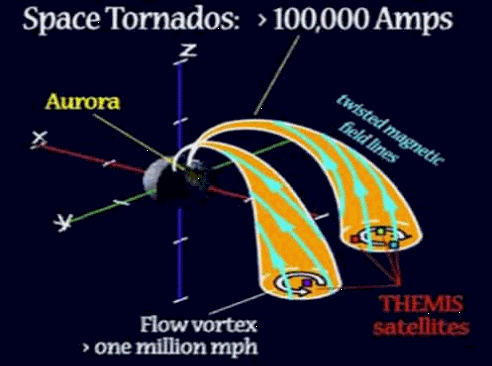
Electromagnetic vortices flowing into Earth's poles. Credit: Andreas Keiling/UC Berkeley.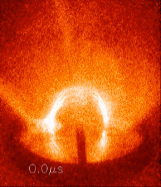
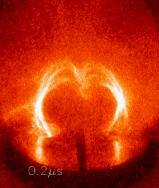

Laboratory simulation of solar plasma flux tubes. Time index 0 - 1.4 microseconds.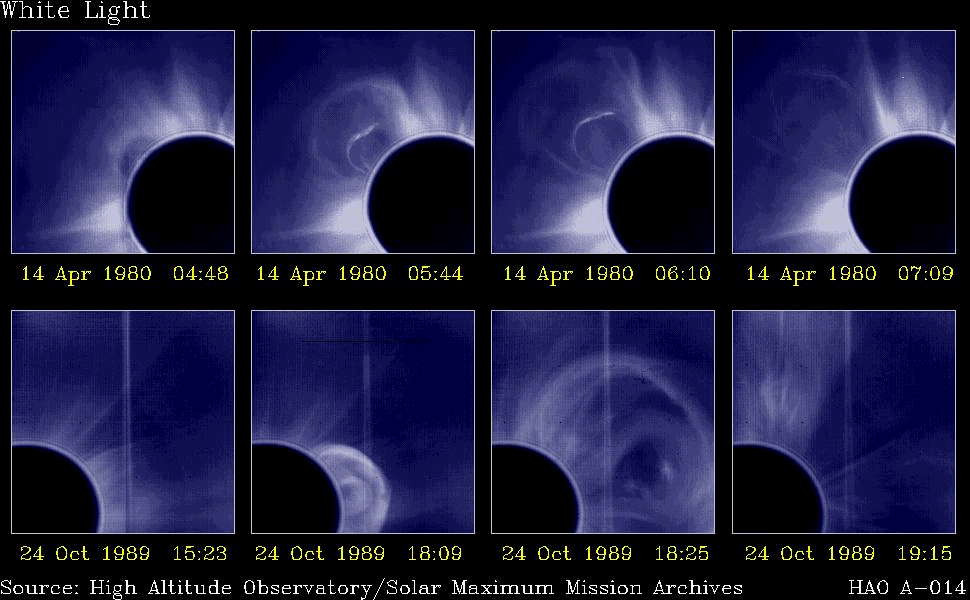
Evolution of a CME. Credit: the Solar Maximum Mission (SMM) satellite (1980)
The Interconnected Sun Part Two
Feb 05, 2010
Electric Weather.One of the more spectacular examples of the Sun/Earth connection are the so-called "red sprites" and "blue jets" that have been seen shooting into space from the tops of thunderstorms. Sprites and jets carry charge distribution from lower atmospheric layers into the ionosphere. They are usually seen at altitudes of between 45 and 90 kilometers.
Space shuttle flights have recorded the glow from sprites and jets as they launched upward toward space. They are essentially reverse lightning bolts—beginning as powerful upward strokes that rapidly diminish into small filaments—and seem to be closing the circuit between the cloud tops and the ionosphere.
![]()

Red sprites and blue jets. Credit: University of Alaska, Fairbanks.
On August 25, 1997, NASA launched the Advanced Composition Explorer (ACE) satellite on a mission to monitor energetic ions coming from the Sun, as well as higher energy particles (cosmic rays) thought to be arriving from intergalactic space.
ACE is in orbit around the L1 LaGrange point approximately 1,500,000 kilometers from Earth and will remain there until 2024. Data from the spacecraft's onboard sensors will provide important information that should help to understand how the solar magnetic field moderates incoming high-speed ions.
During periods of high activity, energetic pulses on the Sun eject charged particles in the billions of tons. They are normally slow moving, requiring about 24 hours to reach Earth. Known as Coronal Mass Ejections (CME), an indication of their arrival is an intensification of the aurorae.
Sunlight reaches Earth in approximately eight minutes. A solar ejection arriving in 30 minutes must be moving at more than a quarter of the speed of light. In the consensus view, such velocities are a profound mystery, yet a gigantic CME was observed on January 17, 2005, that reached our planet in less than half an hour. How do CMEs accelerate to 75,000 kilometers per second or more?
An electric field emanates from the Sun in all directions. The easiest way for charged particles to accelerate is within such a field. The Sun's e-field extends for billions of kilometers, ending at the heliospheric boundary, which the twin Voyager spacecraft are just now beginning to penetrate. Electric fields freely accelerate charged particles, which move outward in opposite directions, activating an electric current that follows the Sun's magnetic field.
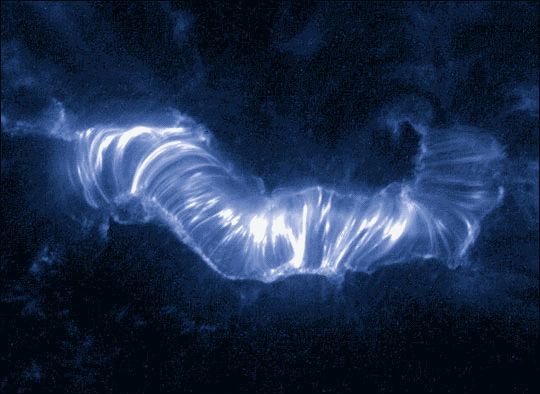
Ultraviolet light image of the Bastille Day 2000 solar flare AR9077. Credit: NASA/TRACE satellite.
As mentioned above, the ionosphere is connected to the Sun by twisting filaments of electric current, so the lower levels of the atmosphere must also experience the Sun's influence because of the additional circuit node that connects them with the ionosphere. Could these electric circuits linking the atmosphere with the Sun have anything to do with Earth's climate in either the short or long term?
On July 14, 2000, the Sun erupted with a massive X-flare, or CME. Solar flares are labeled C, M, or X: light, medium, or powerful. AR9077 was classified as an X5 flare. Until the September 7, 2005, X17 flare impacted Earth's magnetosphere, knocking out radio transmissions and overloading power station transformers, the Bastille Day CME was considered one of the most powerful ever recorded. A veritable cosmic tornado of positive ions poured into the electrically charged environment of our planet.
The Sun is in a relatively quiet stage during this phase of sunspot cycle 24. The Thermosphere, Ionosphere, Mesosphere, Energetics and Dynamics (TIMED) satellite launched by NASA on December 7, 2001, has revealed that the amount of ultraviolet radiation emitted by the Sun has significantly decreased since the beginning of this "solar minimum". Infrared radiation emitted by nitric oxide molecules in the upper atmosphere has also declined, implying that the upper atmosphere is cooling down.
It has long been known that temperatures in the thermosphere are dependent on solar radiation. Extreme ultraviolet light is absorbed by the residual oxygen and becomes electrically charged, with increasing molecular motion. Fast molecular motion is known as heat, so even though a household thermometer would register temperatures below zero in the thermosphere, it is considered hot, sometimes reaching over 1500º Celsius during solar maximum.
Since there are fewer molecules in the thermosphere, the amount of thermal energy per cubic centimeter is lower than it is at the surface—there is not enough contact between molecules to transfer heat.
The Sun's 22 year cycle has now been shown to be linked with Earth's climate. Although solar energy does vary over the course of a sunspot cycle, that variance amounts to less than one-tenth of one percent, so how are the increases and decreases in cloud cover, temperature, and thunderstorm activity explained?

Solar flares erupt from active sunspot regions. Credit: Kitt Peak Vacuum Solar Telescope.
The average annual wind speed on Earth is approximately 56 kilometers per hour, with a maximum gust of 372 kilometer per hour recorded on Mount Washington, New Hampshire in 1934. Some isolated wind phenomena, such as tornadoes and hurricanes, can sustain average velocities of 480 and 320 kilometers per hour for short periods.
Meteorologists are not sure how tornadoes form, but they are often associated with lightning storms. It seems that the key to understanding tornadoes is to think of them as rapidly rotating electric discharges. Just as copper wires carry electrons for power transmission, so do tornadoes. The difference is that electrons are moving at several centimeters per hour in a wire, while flying around at many meters per second in a tornado. The result is that the tornado forms an enormously powerful electromagnetic force field called a "charged sheath vortex."It is commonly believed that weather is driven on Earth primarily by the Sun's thermal influence on the atmosphere, otherwise known as "convection." According to the consensus theory, as Earth rotates gases and dust absorb solar radiation at varying rates and in varying degrees.
When any particular region heats up, the air expands and loses density, creating a relative low pressure area. Cooler air, being denser, will naturally flow into the bottom of the warm, low pressure region, causing an upwardly rotating convection cell to form.

Waterspout with lightning bolt in the Adriatic Sea. Credit: Mladen Duka.
Most weather systems on Earth are thought to be based on that simple kinetic explanation: winds blow when the cooler, denser air flows into the warmer, buoyant air.
The kinetic model of weather does not take into account the fact that planets much farther out in the Solar System have sustained winds that make those on our planet seem like gentle breezes. The average wind speeds on the gas giant planets are fantastic.
Jupiter's winds roar at 635 kilometers per hour around the Great Red Spot; Saturn's average wind speed is 1800 kilometers per hour; Uranus 900 kilometers per hour; and Neptune comes in at 1138 kilometers per hour. On Neptune the winds are blowing through an atmosphere that measures - 220 Celsius. Why is it that the most remote planets, receiving small fractions of the solar energy bathing Earth, are able to convert that small fraction into much larger effects?
As mentioned above, Earth is a charged body moving in a large cell of plasma, so physical phenomena on our planet must take the electrical nature of plasma into account. Perhaps lightning powers the wind? Neptune has some of the strongest winds of any planet in the Solar System, yet it is farthest from the Sun—its frigid atmosphere contradict the thermal model of air movement. Perhaps hurricanes, tornadoes, and even prevailing winds are electrical in nature?
The Electric Universe hypothesis agrees with conventional theory that wind is movement of air molecules, but that there is more to the explanation.
Electromagnetic forces in plasma move and accelerate charged particles, so collisions between charged and neutral particles drag the neutral air molecules along with them. Close observation of laboratory arc discharges reveals that an electric "wind" surrounds and often precedes an electric arc.
A plasma discharge sweeps up the surrounding air along with the charge carriers, or ions. The wind appears as inflows and updrafts as well as outflows and downdrafts. It can lift dust particles and erode surfaces. By analogy, we must then question the accepted explanation of thunderstorms as being caused solely by convection of hot air and the climatological movement of winds by the Sun's heat alone.
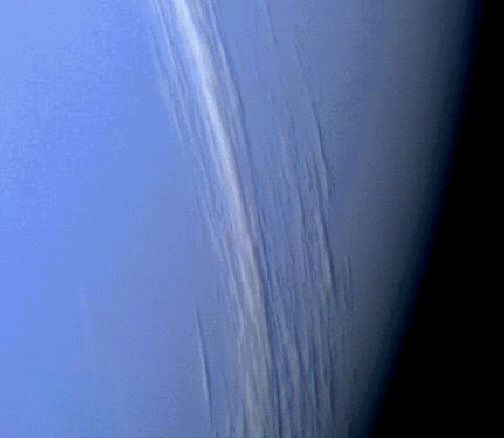
Neptune's winds blow at 1138 kilometers per hour. Credit: NASA/Voyager 2.
Earth is an electrically charged body that interacts with ions permeating space. Electricity from space is also injected into the thermosphere from charged particles emitted by the Sun, speeding along massive Birkeland currents through a closed circuit. When solar winds are at a minimum, the electric currents decline in amperage, thereby decreasing the strength of our planet's magnetosphere.
As the magnetosphere declines in strength, it is less able to deflect energetic ions arriving from deep space known as cosmic rays. Cosmic rays are charge carriers, and those ions are able to reach the troposphere. Collisions between charged and neutral particles drag air molecules along with them, influencing low level cloud cover.
More clouds reflect more radiation from the Sun back to space—clouds are white because they are acting like mirrors to all forms of visible light. More reflection means less solar energy, more cloud cover, and so on.
This leads to the more general idea that all weather may be influenced by the electrical connection between Earth and solar plasma. The larger view has only recently been considered. Experiments designed to verify the effect that charged particles have on Earth's weather are now being conducted by scientists such as Henrik Svensmark and Eigil Friis-Christensen of the National Space Institute in the Technical University of Denmark. However, many experiments have already falsified the mechanical theory of atmospheric convection.
When a weather forecast is wrong it could be considered a falsification of the convection theory. The many erroneous weather forecasts indicate that some other factor (or factors) is missing in the proposal. Electric Universe advocates suggest that a consideration of plasma's electrical properties is the most important missing factor.
Stephen Smith





















